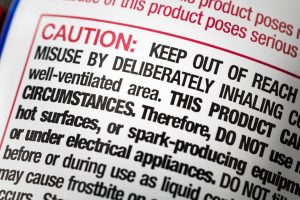Print a Sign-In Sheet | Spanish Version Coming Soon
The Occupational Safety and Health Administration’s (OSHA) Hazard Communication Standard 1910.1200 requires chemical manufacturers, distributors, or importers to provide Safety Data Sheets (SDS) to companies that work with and use hazardous chemicals.
The purpose of the SDS is to communicate the hazards of chemical products. OSHA requires that employers keep SDS on hand for all chemicals employees may use. The following explains the sections and format of SDS:
Section 1 – Identification: Contains information about the manufacturer or distributor, emergency phone numbers, and addresses. This section will also give the product identifier and information on recommended and restricted use of the chemical.
Section 2 – Hazard(s) identification: Discusses hazards regarding the chemicals and required label elements.
Section 3 – Composition/information on ingredients: Gives information on the ingredients in the chemical and any trade secret claims.
Section 4 – First-aid measures: Describes the first-aid care that should be given to an individual who has been exposed to the chemical. It also discusses the symptoms and effects of the chemical.
Section 5 – Firefighting measures: Provides recommendations for fighting a fire caused by the chemical and the techniques for extinguishing the fire.
Section 6 – Accidental release measures: Lists emergency procedures and provides recommendations on the appropriate response to spills, leaks, or releases.
Section 7 – Handling and storage: Provides information on safe handling practices and safe storage of chemicals.
Section 8 – Exposure controls/personal protection: Provides OSHA’s Permissible Exposure Limits (PEL) and Threshold Limit Values (TLV). This section discusses engineering controls and what personal protective equipment can be used to minimize the worker’s exposure.
Section 9 – Physical and chemical properties: Identifies the physical and chemical properties associated with the chemical.
Section 10 – Stability and reactivity: Lists the chemical stability and the reactivity hazards of the chemical.
Section 11 – Toxicological information: Identifies the toxicological and health effects of the chemical. The section also discusses routes of exposure, acute, and chronic effects and gives numerical measures of toxicity.
Section 12 – Ecological information*
Section 13 – Disposal considerations*
Section 14 – Transport information*
Section 15 – Regulatory information*
Section 16 – Other information: Date of preparation and revision dates.
*Note: Sections 12 through 15 are not enforced by OSHA but may be enforced by other agencies.
It is important to review the format and sections with your employees and ensure that Safety Data Sheets are readily accessible.
KEMI does not assume liability for the content of information contained herein. Safety and health remain your responsibility. This information is to be used for informational purposes only and not intended to be exhaustive or a substitute for proper training, supervision, or manufacturers’ instructions/recommendations. KEMI, by publication of this information, does not assume liability for damage or injury arising from reliance upon it. Compliance with this information is not a guarantee or warranty that you will be in conformity with any laws or regulations nor does it ensure the absolute safety of any person, place, or object, including, but not limited to, you, your occupation, employees, customers, or place of business.

